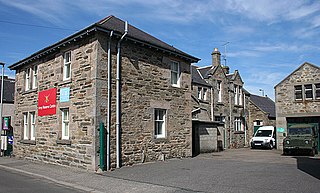The hackle is a clipped plume or short spray of coloured feathers that is attached to a military headdress, with different colours being associated with particular regiments.

The Argyll and Sutherland Highlanders (Princess Louise's) is a light infantry company (designated as Balaklava Company, 5th Battalion, Royal Regiment of Scotland) and was a line infantry regiment of the British Army that existed from 1881 until amalgamation into the Royal Regiment of Scotland on 28 March 2006.

The 51st Highland Volunteers is a battalion in the British Army's Army Reserve or reserve force in the Scottish Highlands, forming the 7th Battalion of the Royal Regiment of Scotland, also known as 7 SCOTS. It is one of two Reserve battalions in the Royal Regiment of Scotland, along with 52nd Lowland, a similar unit located in the Scottish Lowlands.

The Argyll and Sutherland Highlanders of Canada (Princess Louise's), or A & SH of C, is a Primary Reserve Highland infantry regiment of the Canadian Forces, based at John W. Foote VC Armoury in Hamilton, Ontario.

The Scottish Division was a British Army Infantry command, training and administrative apparatus designated for all Scottish line infantry units. It merged with the Prince of Wales' Division, to form the Scottish, Welsh and Irish Division in 2017.

The Royal Regiment of Scotland is the senior and only Scottish line infantry regiment of the British Army Infantry. It consists of three regular and two reserve battalions, plus an incremental company, each formerly an individual regiment. However, three regular battalions maintain their former regimental pipes and drums to carry on the traditions of their antecedent regiments.
The 26th Infantry Brigade was the name of two British Army formations during the First World War and Second World War.

The 27th Infantry Brigade was an infantry brigade of the British Army that saw service in the First World War, the Second World War, and the Korean War. In Korea, the brigade was known as 27th British Commonwealth Brigade due to the addition of Canadian, Australian, New Zealand and Indian units.
The 152nd Infantry Brigade was an infantry brigade of the British Army that fought during both the First and the Second World Wars.

153rd Infantry Brigade was a formation of Britain's Territorial Force/Territorial Army that was part of 51st (Highland) Division in both World Wars. From its origins in the 19th Century Volunteer Force it was based in Aberdeen and was composed of Highland battalions. It served on the Western Front in World War I, and after it was captured at Saint-Valery-en-Caux early in World War II it was reformed from its 2nd Line and saw action in North Africa, Sicily and North West Europe. It continued serving postwar until the reduction of the Territorial Army in the 1960s.

154th Infantry Brigade was a formation of Britain's Territorial Force/Territorial Army that was part of 51st (Highland) Division in both World Wars. From its origins in the 19th Century Volunteer Force it was based in Stirling and was composed of Highland battalions. It served on the Western Front in World War I, and after it escaped from France early in World War II it was reformed from its 2nd Line and saw action in North Africa, Sicily and North West Europe. It continued serving postwar until the reduction of the Territorial Army in the 1960s.
The 45th Infantry Brigade was an infantry brigade of the British Army that saw active service in both the First and the Second World Wars with 15th (Scottish) Infantry Division.

Forthside Barracks is a military installation in Stirling, Scotland.

The Hunter Street drill hall is a military installation in Kirkcaldy, Scotland.

The Ferry Road drill hall, known locally as Seaforth Barracks, is a military installation in Dingwall, Scotland.

The Old Bank Road drill hall is a military installation in Golspie, Scotland.

The Cooper Park drill hall is a former military installation in Elgin, Scotland.

The Union Street drill hall is a military installation in Keith, Scotland.

The High Street drill hall is a former military installation in Paisley, Scotland.

The Princes Street drill hall is a former military installation in Stirling, Scotland.
















